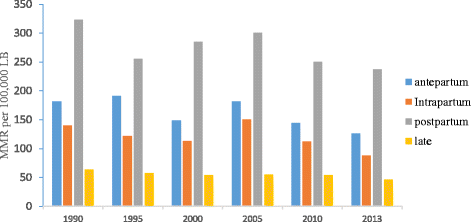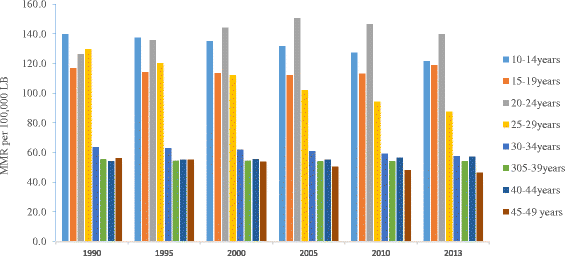Trends and causes of maternal mortality in Ethiopia during 1990-2013: findings from the Global Burden of Diseases study 2013
- PMID: 28152987
- PMCID: PMC5290608
- DOI: 10.1186/s12889-017-4071-8
Trends and causes of maternal mortality in Ethiopia during 1990-2013: findings from the Global Burden of Diseases study 2013
Abstract
Background: Maternal mortality is noticeably high in sub-Saharan African countries including Ethiopia. Continuous nationwide systematic evaluation and assessment of the problem helps to design appropriate policy and strategy in Ethiopia. This study aimed to investigate the trends and causes of maternal mortality in Ethiopia between 1990 and 2013.
Methods: We used the Global Burden of Diseases and Risk factors (GBD) Study 2013 data that was collected from multiple sources at national and subnational levels. Spatio-temporal Gaussian Process Regression (ST-GPR) was applied to generate best estimates of maternal mortality with 95% Uncertainty Intervals (UI). Causes of death were measured using Cause of Death Ensemble modelling (CODEm). The modified UNAIDS EPP/SPECTRUM suite model was used to estimate HIV related maternal deaths.
Results: In Ethiopia, a total of 16,740 (95% UI: 14,197, 19,271) maternal deaths occurred in 1990 whereas there were 15,234 (95% UI: 11,378, 19,871) maternal deaths occurred in 2013. This finding shows that Maternal Mortality Ratio (MMR) in Ethiopia was still high in the study period. There was a minimal but insignificant change of MMR over the last 23 years. The results revealed Ethiopia is below the target of Millennium Development Goals (MGDs) related to MMR. The top five causes of maternal mortality in 2013 were other direct maternal causes such as complications of anaesthesia, embolism (air, amniotic fluid, and blood clot), and the condition of peripartum cardiomyopathy (25.7%), complications of abortions (19.6%), maternal haemorrhage (12.2%), hypertensive disorders (10.3%), and maternal sepsis and other maternal infections such as influenza, malaria, tuberculosis, and hepatitis (9.6%). Most of the maternal mortality happened during the postpartum period and majority of the deaths occurred at the age group of 20-29 years. Overall trend showed that there was a decline from 708 per 100,000 live births in 1990 to 497 per 100,000 in 2013. The annual rate of change over these years was -1.6 (95% UI: -2.8 to -0.3).
Conclusion: The findings of the study highlight the need for comprehensive efforts using multisectoral collaborations from stakeholders for reducing maternal mortality in Ethiopia. It is worthwhile for policies to focus on postpartum period.
Keywords: Ethiopia; Global Burden of Diseases; Maternal mortality; Trends.
Figures





References
-
- United Nations. The Millennium Development Goals Report 2015. New York: United Nations; 2015.
-
- Kassebaum NJ, Bertozzi-Villa A, Coggeshall MS, Shackelford KA, Steiner C, Heuton KR, Gonzalez-Medina D, Barber R, Huynh C, Dicker D, et al. Global, regional, and national levels and causes of maternal mortality during 1990-2013: a systematic analysis for the Global Burden of Disease Study 2013. Lancet. 2014;384(9947):980–1004. doi: 10.1016/S0140-6736(14)60696-6. - DOI - PMC - PubMed
MeSH terms
LinkOut - more resources
Full Text Sources
Other Literature Sources

